The expropriation and demolition of LeBreton Flats is the one crime above all for which the NCC should be taken to account
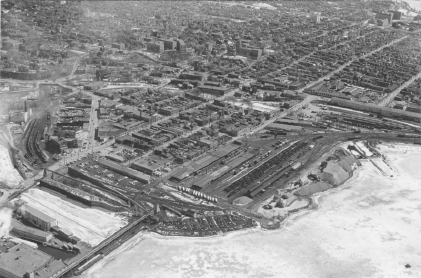
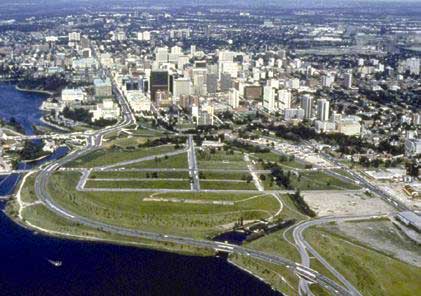
The LeBreton Flats lie just to the west of Parliament Hill. One of Ottawa's original industrial areas, the Chaudiere Falls powered a mix of timber production and light industry, along with rail yards and worker housing. Completely devastated by fire in 1900, it quickly built itself back up again.
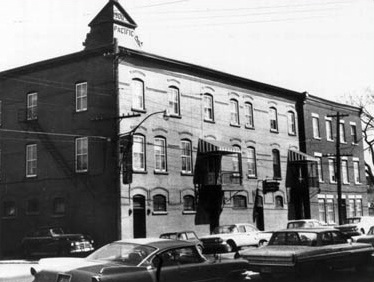
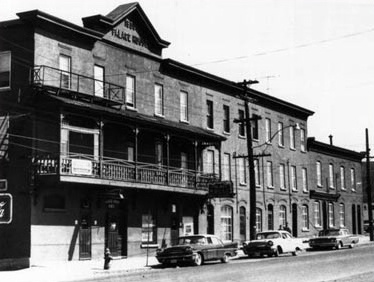
On April 19 1962, the 2,800 odd residents and property owners of the LeBreton Flats received a notice that began "This letter will advise you that on April 18 1962, the National Capital Commission filed a notice of expropriation covering the property at [your address]." The NCC had been working on the expropriations in secret for years. Appraisers, solicitors, and finally demolition crews followed behind the notices. The last building was torn down by the end of 1965. Total cost, about $15 million.
A spectacular government development of 154 acres of land known as LeBreton Flats just west of Parliament Hill was announced by Public Works Minister Walker today. The government acted yesterday to expropriate 53 acres from 240 landowners in the area, embracing a mixture of industrial plants, commercial buildings and low-standard housing. Ultimately, the government will spend more than $70 million on about 10 government buildings in the area, with the first of them to be completed by Canada's 1967 centennial.
Ottawa Citizen April 19, 1962
The expropriation was part of the Greber plan, a monument to the planning ideals of the middle 20th century. The LeBreton Flats were demolished so that "the foreground to Parliament Hill, when viewed from the west, will be greatly improved." And the "slum residents" who lived there will be much better off for it. The land has lain waste ever since. It seems a neighbourhood can recover from acts of God, but not those of government.
LeBreton Flats Remembered [Facebook page]
An Acre of Time, history of the LeBreton Flats
Citizen: Falling in love on the Flats [13 March 2001]
Journal: LeBreton Flats project falters [7 Aug 1976]
Greylands LeBreton Flats history
NCC LeBreton Plan
Ottawa Past and Present: LeBreton Flats
YouTube: 1965 vs 2014 LeBreton Flats
Planning to do nothing
Plans for the flats came and went as the NCC has waffled endlessly over concepts, designs and visions. Years became decades as a grand housing project, the Department of National Defence, various other government buildings and even an aquarium were considered for the site. The most notable uses to which the land was put, however, were an appearance by the pope, a camp ground, and a snow dump, which left part of the land polluted.
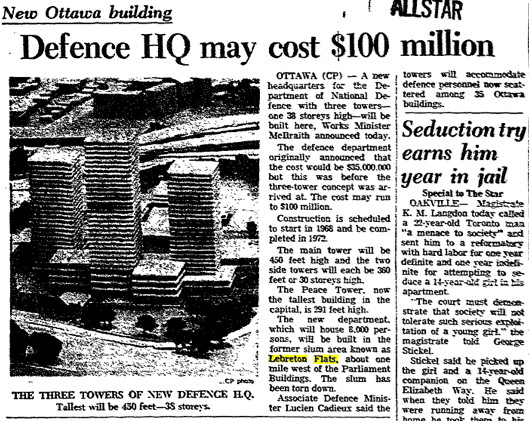
The Toronto Star reports the latest plan
June 2, 1966
OBJ: LeBreton Plan Inches Forward [5 Jun 1999]
Citizen: LeBreton Flats Deal Signed [9 Nov 1999]
Centretown News: NCC Takes Command [26 Nov 1999]
The NCC, trying to put the best possible spin on the monumental fiasco, insisted that it had to "ensure that land in the Capital is available for uses of national importance." According to the NCC, the LeBreton Flats weren't a vacant lot, but "an opportunity to ensure that there is a place for buildings of national significance in the future." In other words, the flats were torn down just in case there was an urgent need for a new monument of some kind. Recall for a moment that the NCC has planners on staff.
The NCC acquired the land in 1962 for new government buildings; however, roadways remained under municipal and regional ownership, and three-way negotiations about the future of LeBreton Flats stalled. Since then, the location continued to prove its value as a site for occasional festivals and public events.
The NCC pretends the last 40 years weren't
a complete waste of time on its website
In 1999, the NCC proudly announced that it now owned 100 percent of the land and things would really start to happen. Apparently, the city still owned the roads until the agreement was reached, and, up 'til now this had presented some sort of insurmountable roadblock. Well then. It took the NCC about 15 minutes to expropriate property from people who lived there, but coming to an agreement about the roads owned by another level of government was one of the labours of Hercules. Guess it would have somehow been bad form to expropriate from another level of government.


In March 2000, the NCC released a new plan for the flats, along with five other projects designed to "revitalize" the downtown core. The plans included space for homes, commercial buildings and, as usual, some monuments and ceremonial plazas thrown in for good measure.
Before development could proceed, however, the site still had to be decontaminated - just one more detail it's taken them 40 years to address. The NCC finally announced in September 2000 that a plan would be complete by spring 2001, but by the fall of 2001, they still weren't sure whether the stuff would be trucked away or buried onsite, or whether it would cost $30 or $50 million.
NCC's Latest Concept
Centretown News: LeBreton Plans may be too Slow [31 Mar 2000]
CBC: Toxic LeBreton soil [16 May 2001]
Citizen: Capital to get facelift [15 May 2001]
In spring of 2001, rumours started to circulate that the new War Museum, already planned for the East end (beside the Aviation Museum), was going to be put on the Flats instead. Sure enough, in May Sheila Copps breathlessly announced "a strategy for revitalizing Canada's capital." In short, the War Museum would indeed be going up, and the contaminated soil would be on the way out. Only 40 years on, and the flats finally saw some development. Unfortunately, the most notable feature of the development aside from the new museum is the six-lane "LeBreton Boulevard" that will bisect the area.
CBC: War museum's new home? [20 Feb 2001]
CBC: New home for War Museum [16 May 2001]
Buzz: War Museum moving ahead [20 Jul 2001]
Centretown News: LeBreton clean-up delayed [9 Nov 2001]
Centretown News: Concerns linger about Flats plan [23 Nov 2001]
CBC: What's the story in LeBreton Flats? [26 Apr 2002]
CBC: Digging for history at LeBreton Flats [8 May 2002]
Globe and Mail: Construction of new museum sparks renewal [1 Jun 2004]
Developing with beige
In 2004, the NCC announced Phase 1 of development of the rest of the Flats, a 4.4 hectare site to be filled with stacked townhomes and office blocks, all to be in varying shades of brown. To keep up the pretense that building housing in Ottawa is somehow of national significance, the NCC also announced that the decision about who will develop the land will be taken by an advisory committee made up of appointees from across the country, but graciously allowed that the general public will get a chance to view developers' proposals before the final selection is made. A shortlist of developers who would be allowed to bid on the land was announced in May, along with a 50 page manual of design guidelines for those brown buildings.
CBC: NCC looks beyond War Museum [27 Feb 2004]
OBJ: History at home on LeBreton Flats [19 Apr 2004]
OBJ: NCC releases shortlist for LeBreton Flats [14 May 2004]
CBC: NCC sets colour palette for Flats [26 May 2004]
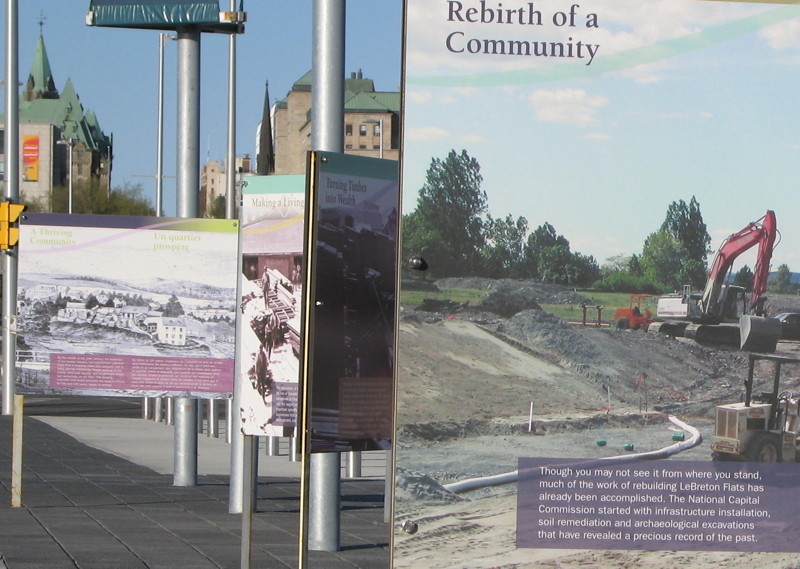
Sixty years later, and much, apparently, has been accomplished.
This installation of banners and posters promoting the NCC, for example.
The NCC's refusal to break the 4.4 hectare block into smaller lots meant smaller developers were shut out. In the end, they got three bids for Phase 1, and two of them ended up withdrawing. The "winning" developer, Claridge, was a distant third in the NCC's own evaluation of proposals for the LeBreton project - Minto had the highest overall score of 62.02 out of a maximum of 70, followed by Prevel with 61.65, while Claridge trailed with 54.04. Both Minto and Prevel withdrew from the final stage of the competition after the NCC tacked on demands for a minimum land price of $7.5 million, the right to repurchase the property and a requirement that 25 per cent of the housing be affordable, leaving also-ran Claridge with the "prize." Prevel even had to threaten the NCC with lawyers to get their $50,000 deposit back. Only two days before Claridge signed on, the NCC was begging Minto (Minto!) to reconsider, but Minto was unmoved.
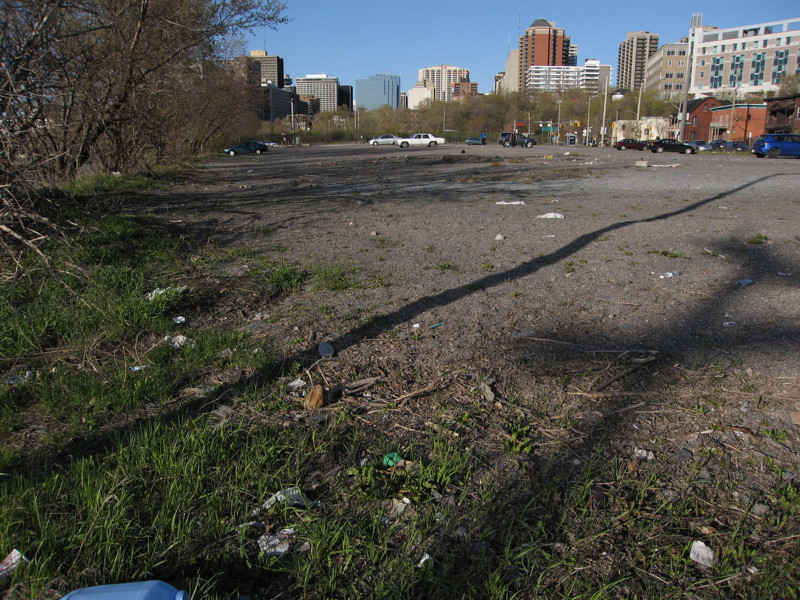
And so we are left with a (literally) third-rate project after 40 years of futility. Architect Ron Keenberg summed it up in a Citizen article:
It is a normal, pedestrian housing development that could have been anywhere in Canada. It is certainly not a scheme that is reflective of the national capital region. Obviously the NCC knew they were dealing with the bottom of the barrel, but they didn't care. (NCC chair) Marcel Beaudry was a bad developer and he is imposing his low development taste on Ottawa.
Despite the fiasco, the NCC sees nothing wrong with its process and will use a similar one for the next phase of the LeBreton development.
OBJ: Claridge picked to develop LeBreton [2 Dec 2004]
Centretown News: LeBreton housing project to start next fall [10 Dec 2004]
Centretown News: Builder says low-cost housing target met [29 Oct 2004]
NCC: Phase 1
Corsoitalia.net: LeBreton Development
A large piece of empty land along the western edge of the downtown Capital, LeBreton Flats has lain virtually idle since it was cleared of housing and light industry in the 1960s.
The NCC recaps the history of the Flats in its 2002 annual report